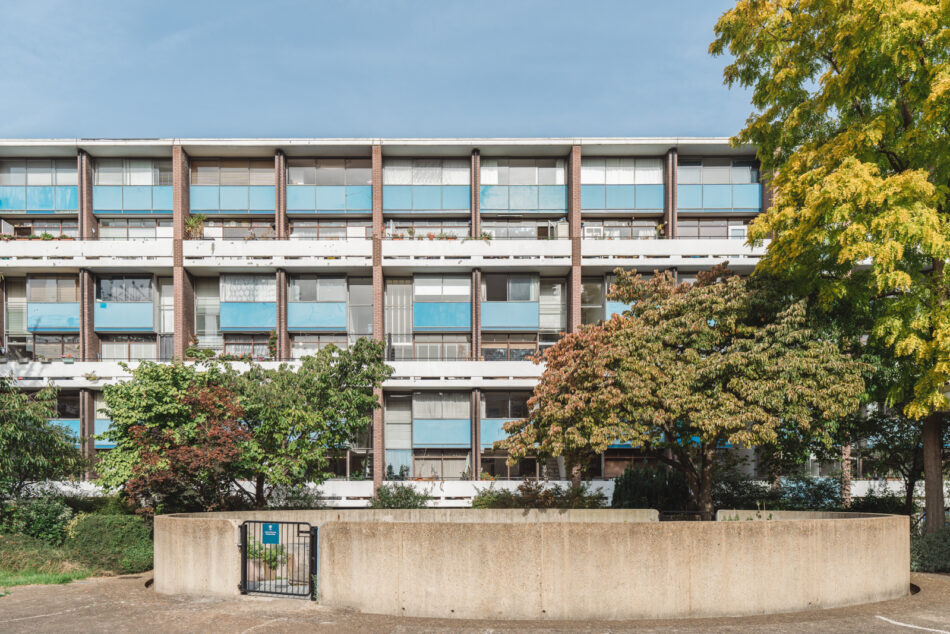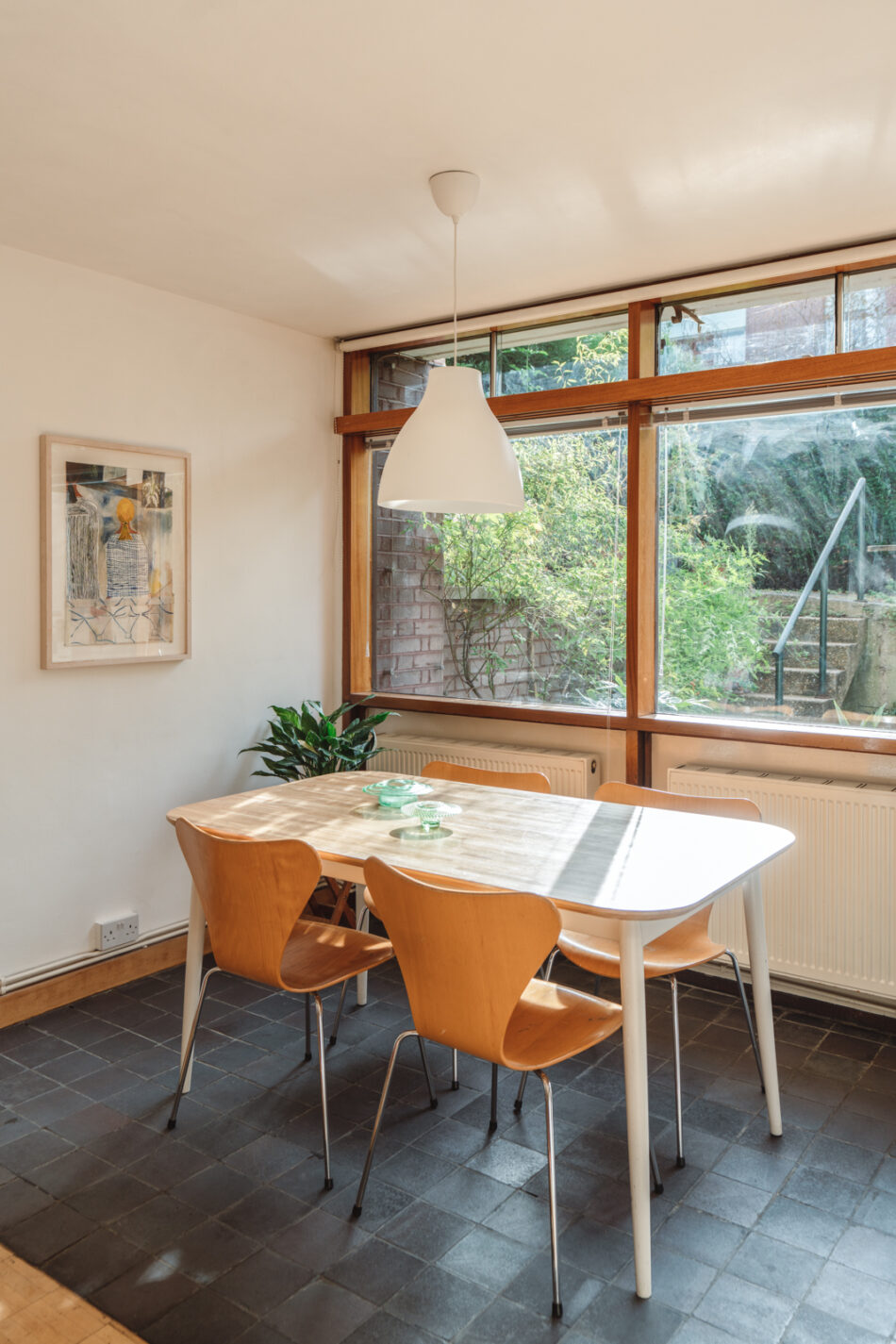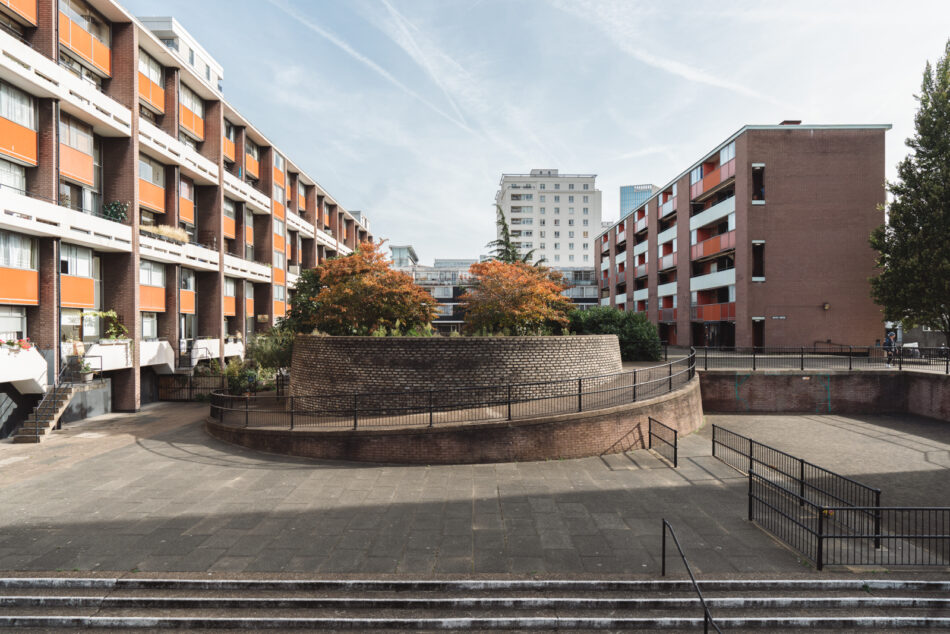















Hatfield House
Golden Lane Estate, London EC1
Architect: Chamberlin, Powell & Bon
Register for similar homes“A beautifully preserved apartment in the heart of Chamberlain, Powell & Bon's iconic Golden Lane Estate”
This beautiful studio apartment lies within the Grade II-listed Golden Lane Estate, the pioneering project that saw the creation of renowned architectural practice Chamberlin, Powell & Bon. It is positioned on the lower-ground floor of Hatfield House, and has a beautifully planted private rear garden. The estate’s design embraces the urban environment; the blocks look inward over landscaped courtyard gardens, while pedestrian walkways connect the buildings and replace the pre-war road patterns. The celebratory use of bold colours on the outside of the buildings was integral to the design, and each block has a slightly different take on the combination of colour, concrete and glass.
The Architect
In 1951, the City of London ran a competition for architects to submit plans for a scheme to replace buildings destroyed by a night of bombing in December 1940. The proposal was to be called the Golden Lane Estate. Peter Chamberlin, Geoffrey Powell and Christoph Bon all submitted plans and agreed that if one of their practices won, they would form a partnership and work together on the project. Powell won the competition, and thus Chamberlin, Powell & Bon was formed in 1952. After their success with the Golden Lane Estate, the firm was asked to design the Barbican Estate, which has arguably become London’s most iconic brutalist complex. For more information on the building, please see the History section below.
The Tour
Discussions are ongoing regarding the upgrading and restoration of the Golden Lane Estate, including the replacement of all windows. Dates for this are yet to be finalised; official estimates from the City of London (March 2023) can be provided upon request.
Hatfield House is instantly recognisable care of its distinctive blue panelling, which contrasts with white balconies, red window frames and dark brick construction. Colour played an important part in Chamberlin, Powell & Bon’s early designs, married with the rich wood, concrete and terracotta tiles that they continued to use in later projects.
Entry is a few steps down from ground level, where a private front door opens into a hallway that contains large cupboards for storage space. The studio is a beautifully bright space that offers great versatility in terms of layout. The living area is currently positioned in front of a generous built-in bookcase, while the dining area sits in front of an expanse of glazing that frames views over the garden. These spaces have wooden floors, allowing the kitchen to be delineated by a shift to slate underfoot.
The kitchen has ample cabinetry with stainless steel fronts, wooden worktops and a simple, white-tiled splashback. Although not original, it has been executed in complete harmony with the original design of the estate in terms of both materiality and design.
To one side, an alcove cut into the wall currently houses a single bed with storage underneath. This area can be concealed from the main room by original sliding pocket doors. However, this space would work equally well as a cosy reading nook, with a bed positioned in the main room instead.
The bathroom lies behind these spaces and has a beautiful, Japanese-style wooden bath.
Outdoor Space
A paved garden extends behind the apartment. South-facing, it receives a wonderful quality of light throughout the day and has views to the other colourful buildings within the estate. The space is framed by raised borders; other planting includes jasmine and passionflower.
The Area
Hatfield House is near an excellent selection of restaurants, pubs and bars, including the nearby Smithfield Market, St. John, Luca and The Quality Chop House. Farringdon and Old Street are within walking distance, both known for their excellent restaurants. There is a food market every weekday at nearby Whitecross Street. The Barbican Centre facilities are also within easy walking distance.
Transport links are excellent, with Underground stations at nearby Barbican (Circle, Hammersmith & City and Metropolitan Lines), Old Street (Northern Line), Farringdon (Circle, Hammersmith & City, Metropolitan and Elizabeth Lines) and Moorgate (Northern, Hammersmith & City, Circle and Metropolitan Lines).
Tenure: Leasehold
Lease Length: approx. 174 years remaining
Service Charge: approx £886 per annum
Ground Rent: approx. £10 per annum
Council Tax Band: C
Please note that all areas, measurements and distances given in these particulars are approximate and rounded. The text, photographs and floor plans are for general guidance only. The Modern House has not tested any services, appliances or specific fittings — prospective purchasers are advised to inspect the property themselves. All fixtures, fittings and furniture not specifically itemised within these particulars are deemed removable by the vendor.




History
“Golden Lane straddles the boundary between the picturesque and the formal, its rectilinear plan and hard landscaping eased by the changes in level, natural materials and circular bastion” – Elain Harwood
By 1951, only 5,000 residents remained in the City of London following the devastation of World War II. Concerned that people working in vital industries such as hospitals and the police force needed housing in the centre of the city, the City of London Corporation announced an architectural competition for schemes to provide new homes. The brief was to provide quality, high-density housing for singles and couples, using economical methods of construction with as little steel as possible – after shortages due to the war. Each apartment was to have heating and hot water included in the rent, and it was stipulated that there should be plenty of natural light. There was to be a community centre, sports facilities and a playground, to encourage a distinct and sustainable community.
One of the most important post-war architectural practices, Chamberlin, Powell & Bon, was born out of this opportunity. Having separately submitted proposals and agreeing that whoever won would join forces with the others, Geoffrey Powell, Christoph Bon and Peter Chamberlin jointly designed the Golden Lane Estate. Many of the ideas that define their later and better-known project at the Barbican had their genesis in The Golden Lane Estate. The design embraces the urban environment; the blocks look inward over landscaped courtyard gardens, while pedestrian walkways connect the buildings and replace the pre-war road patterns. The celebratory use of bold colours on the outside of the buildings was integral to the estate’s design, and each block has a slightly different take on the combination of colour, concrete and glass.





